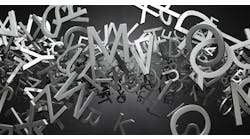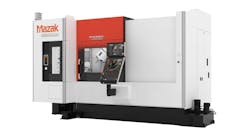A new machine is making serious business of tool and cutter grinding by combining a number of innovative features
ANCA's wheel changer system switches wheel packs in mid-cycle, letting operators precision grind a single tool using up to eight different grinding wheels.
One ANCAblock precision chuck clamps a range of shank diameters and eliminates chuck changeovers for unmanned operations.
CIMulator 3D displays the exact shape of a cutting tool and manipulates the image for viewing from any perspective.
A TGX CNC grinding system from ANCA showcases the company's latest technological advancements in cutting tool resharpening and manufacturing.
Just introduced at EMO '97, the TGX is in hot demand with U.S. firms already placing 35 orders. Its manufacturer, the Australia-based ANCA, expects that this number will double by mid-'98. The reason for the tremendous response, according to ANCA, is several innovative new features that give even the small shop the capability to handle different jobs.
Although the machine's structure lends itself well to large tool-manufacturing houses, the majority of orders are from 20 to 30-man shops that resharpen complex cutter geometries. But a growing trend, says Russell Riddiford, ANCA vice president, is that today's cutter resharpening houses are securing their futures by also manufacturing tools. And he believes ANCA advancements in controls, software, workholding, drive systems, and wheel spindles give shops this diversifying option.
CNC and software
Having experience as a CNC manufacturer, ANCA designs and builds TGX controls and software. Called 3DX CNC, the system simultaneously controls up to 20 axes. It incorporates 32 Mbyte of memory and a 1.44 Gbyte hard disk along with an 8-speed CD-ROM for software demos, upgrades, and training. This new generation CNC, as ANCA terms it, displays grinding cycles in 3D accuracy using graphically based tool software within the CNC.
Once the software displays a cutter on screen, operators enter parameters such as diameter, pitch, radius, and number of flutes. Check-mark type screens then prompt users for yes or no answers. All of which, says Riddiford, makes the machine ideal for different short-run jobs. Because, he adds, the key to grinding one or two of a certain cutter is not in the machine, but in the software.
Two support-software packages, called Ordermate and Palletmate, fully automate the TGX system. Machine pallets house 120 tools for resharpening or blanks for toolmaking. Operators, via Ordermate, then designate tool type, quantity, and running schedules.
For example, the machine might designate the first five tools as ball-nose, the second five as corner radius tools, and the remainder as left-hand cutters. In the event of multiple pallet use, Palletmate software scans the sides to make sure the correct one is loaded.
ANCA compliments automating software with its universal tool-chucking system called ANCAblock. Just one chuck clamps a range of shank diameters and eliminates chuck changeovers for unmanned operations. Three ANCAblock models handle diameters between 0.236-0.500 in., 0.500-0.750 in., and 0.500-1.000 in. In addition to software within the CNC, ANCA has developed a separate software package for the TGX system. Called CIMulator 3D, it displays the exact shape of a tool to be ground and manipulates the image for viewing from any perspective. CIMulator then calculates relief, hook, helix, and axial rake angles for any point on the tool. Color-coding highlights wheel points-of-contact and interferences prior to actual grinding. The system typically runs on a separate PC in a CAD/CAM room, for instance, and downloads data to the TGX through a direct link or by floppy disk.
Machine movement
ANCA combined digital drive with direct-drive axes and eliminated gearboxes, gears, and belts, along with the related problems of belt wear and backlash. For TGX's spindle, manufactured in-house, it means energy efficiency and low noise levels, even at 8,000 rpm with a constant torque of 24 hp.
According to Riddiford, three axes—headstock A, rotary C, and the spindle—are crucial in generating complex geometry tools. If a machine drives those axes by belt or gearbox, it increases the possibility of vibration or backlash.
Although direct drive is nothing new, mentions Riddiford, it is new to the tool and cutter grinding industry—as is the patented ANCA term "soft axis."
The company derived the term from a robotics industry concept where 2 or 3 simultaneous axes movements generate a new plane or axis path. What this means for the TGX is that its control has the mathematical capability to initiate 2, 3, or even 5 axes together and create a direct path (soft axis) to a single point within the machine. These complex movements require more information be passed around to machine components and at a rapid pace.
To accommodate the traffic, ANCA uses fiberoptic cables. Fiberoptics, says Riddiford, transfer more information through less cable. He points out that only 8 cables run throughout the TGX.
Automatic wheel changing
Breaking from the common double-ended spindle configuration, ANCA instead engineered automatic wheel changing for the TGX. The machine's wheel changer system can switch wheel packs in mid-cycle to provide the most optimum wheel or combination of wheels for a particular application. If need be, operators can precision grind a single tool using up to eight different wheels.
Wheel packs are an over-and-under design and attach to the spindle with an HSK standard arbor. Pushing a foot-operated switch releases the pack, or it can be done manually in seconds. Threaded lock-nuts, instead of typically used socket-head cap screws, secure grinding wheels to the arbor. Riddiford adds that the wheel pack also offers two main advantages over conventional double-ended spindles.
The first is that wheels with different surface speeds can be mounted on one pack. With a double-ended spindle, wheels at both ends must be compatible in regards to their maximum allowable rotation speeds.
The second advantage is an option of running the spindle either clockwise or counterclockwise. This is made possible by the HSK wheel arbors.
Although there seems to be a market trend towards double-ended spindles, ANCA decided not to go with the configuration for two reasons. The first, says Riddiford, is it can be less rigid and require a large machine size for traversing to both ends. Secondly, the double-ended configuration wouldn't accommodate ANCA's proposed engineering advancements.
For instance, engineers wanted to do away with the spindle belt-drive system in addition to hydraulically powering the wheel arbor for clamping and unclamping—two things, says Riddiford, aren't possible with a double-ended spindle.
Choosing a single-end spindle design let ANCA keep the diameter large and sturdy. It also eliminated any thermal expansion problems associated with running double-ended spindles at high rpm.






